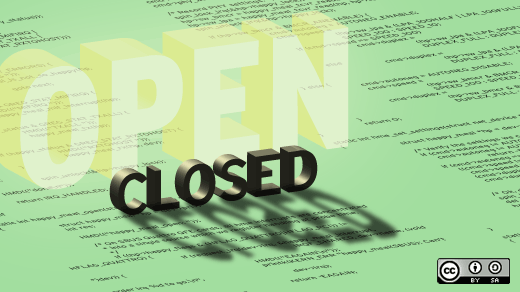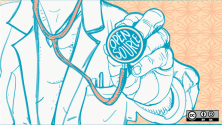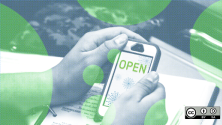What a difference three years makes. It seems quaint now that in the 2008 NEJM there were concerns raised about the flow of health information onto the web. Back then there was but a faint trickle of what could be entered, mostly by hand, and accessed on the web. Before HITECH and health care reform, exchanging health data online seemed blasphemous to many hospitals, patients, and physicians alike.
Fast forward to today and where we are now:
- Around 75% of physicians have smart phones (the web in their pocket), and will reach 80% in 2012.
- Major vendors have opened or are preparing to open their APIs in some fashion.
- Almost every major EHR vendor has or is working on an iPad application (a web tool).
- HealthVault has already begun to receive info via The Direct Project for the Care360 EHR.
- Connectivity and interoperability are quasi-law.
- Web-based EHRs have come to the forefront for many practices.
It’s great progress, and this is an amazing jump from where we were, but it’s far from an economy of health information. The problem is that there is still little patient data to pull from. None of the top 20 iPad health care applications even have connections to EHRs.
If health information is a sort of currency, then what we are seeing is that physicians are beginning to recognize its value. Physicians (and patients, too) are pulling for new functionality and opportunities to use health data, but for the data that really matters, patient data, they’re coming up empty.
What we need to achieve a health information economy
In 2009, in a follow-up to the NEJM article, Mandle and Kohanne (the same authors that wrote the 2008 NEJM paper) describe what they believe is required to develop a robust health information economy:
- Liquidity of data (access and exchange)
- Substitutability of applications
- Open standards
- Competition and diversity of applications over functionality, not data.
I like this, and it’s similar to what I’ve found over the years. As a personal mission, I’ve been researching information economies for almost a decade, and it’s clear that there is a repeated pattern in their development:
Information economies must be put into a single system where information can be found, accessed, trusted, exchanged, and then recombined. These elements, together, allow information to flow to where it’s needed in a form where it can be easily acted upon that fits the job to be done (Christensen's cornerstone of value creation and disruptive innovation) at that moment.
Similar to Mandle and Kohanne, my definition begins with what is essentially data liquidity, which happens via access and exchange (but also requires systemic trust). Once we have access and exchange, competition will drive better, more innovative products to deliver information where and when it’s needed.
Why we’re not there
It’s certainly no surpise to anyone reading this that data liquidity is sorely lacking in health care. Too long, competition among those providing and consuming health care information has been driven by restricting access (via data lock-in) to information. It’s the major reason we have big, monolithic EMRs that are poorly designed, confusing, difficult to use, and rarely (if ever) customized to the needs of that doctor and that patient at that time. Without access to data, there is no basis for competition to drive better designed software. You simply can’t compete without the data.
Holding back the power of 2.0 and collaboration
For all the talk of Health 2.0, lack of data liquidity is significantly preventing collaboration. Several companies have built great physician networks, but without any way to exchange the health information that matters: information about real, current cases. These networks have had to rely on reentry of data or, in many cases, limiting content discussions out of fear of HIPAA or FDA violations. So there’s still no way to collaborate effectively around the jobs they have at the moment: treating patients. Successful collaborative tools in medicine simply must:
- allow physicians to collaborate on actual cases in at trusted environment of peers
- do so without requiring data reentry
- have systemic trust (no fear of sharing for security or regulatory reasons)
- be worked into their current workflow
HIPAA, for better or for worse, has given providers cover for locking in data, and that’s only led to high-friction (not liquid) exchange of data via fax, email, and phone. A combination of fear and mistrust has driven valuable data into places where it has little use beyond where it’s called from: paper charts, monolithic systems, the minds of patients, or within one clinic on the far side of town. In order to gain access, much less exchange information, you have to know what data is available, where it is, and you have to ask for it. So mostly physicians work on their own without relevant data, or worse, recreate it through additonal testing at enormous costs.
Systems that have open exchange, such as Kaiser, even $5 billion of investment in HIT, are reaping rewards. When all providers can compete in an open network of information, they can compete on how they use the information rather than on hoarding information.
Things are changing
Fortunately, meaningful use is providing the incentive for many institutions that previously had none for digitizing and freeing health info, while the Direct Project or others may be a significant step in providing the means for all to exchange health info.
Stage I of Meaningful Use was largely focused on capture and exchange of health data. Stages II and III are focused on using that information in a meaningful way in clinical workflows. While I’m sure that stage II and III will have the desired effects of speeding industry adoption of Meaningful Use of EHRs (even if there’s debate on the directions), but I also wonder how much stages II and III are needed once data is liberated. We’ve seen in many instances before that once data is liberated, it will find its way to where it’s needed.
And that’s the real benefit I see with the Direct Project: it may allow for new companies and new business models for managing health data. Although designed for point-to-point transmissions to replace fax and phone, it may also make data easier to consolidate. Business models for technology companies may arise for making sense of the data, possibly on a population level and personalized level, then delivering it where and when it’s needed.
The floodgates of health information capital may be starting to open--it’ll be interesting to see what forces now pull at the data.
Meanwhile, health care reform may start to reduce the amount of mistrust and fear that exists around health data. If you can’t lose your insurance (the part that both parties like), will you still be as afraid that your health data gets out? Will people feel like it’s just data again, akin to financial statements? It’s still too early to measure the impact, but if PatientsLikeMe is already working, and people are sharing data with drug companies and anyone else who wants to know, then the potential that will exist when people are no longer fearful of losing insurance will be even greater. Trust is easier when what you share can’t be used against you.
Where are we headed?
To get to a true health information economy, health info has to travel from its vast untapped repositories to where it’s needed. Once it’s liberated, data will flow to help patients and physicians make better choices and continue learning while technologists use that data to provide better solutions.
In The Power of Pull, John Hagel III, John Seely Brown and Lang Davison at Deloiitte’s Center for the Edge describe how access, trust, and collaboration enabled through Web 2.0 are quickly accelerating advances in many companies and in many fields. The first step is access. Through access come the connection, exchange, and trust that drive the emergence of higher order innovations. One of the key points highlighted by the Power of Pull authors and others is that sharing information drives Pull. Pull in a connected world lets solutions find you. Once physicians and patients can exchange health information in a meaningful way online, they will. The benefits in outcomes are just too big to ignore.
Of course, in true counterintuitive fashion, health data will have a chance to experience the Power of Pull, but enabled via Push technologies in the Direct Project, but it’s a big step forward.
PatientsLikeMe is a prime example. Sharing becomes a small price to pay for better decision-making ability. Even though PatientsLikeMe is very openly funded by pharma, patients share openly. Part of that is the sense of community, but more of it is surprisingly and refreshingly data-centric. People share because they want results. They recognize they can increase the knowledge researchers, physicians, and fellow patients have of disease. Data liquidity will make it even more so, and better outcomes will result. It’s like an investment and spending of currency in a thriving economy. You spend it because you trust that you or someone you love will get more in return.
Better outcomes find us when we can find better information to make decisions without managing that information. That, in essence, is what a true health information economy will look like. I have high hopes that we’ll remember 2011, through health care reform, meaningful use and new chances for interoperability, as the year that health data became truly liquid.
Join the Clinical Groupware Collaborative
This article was originally posted on HL7 Standards Health blog, engaging conversations on healthcare and technology






4 Comments